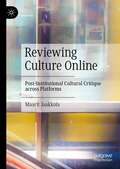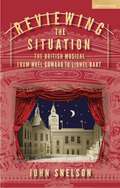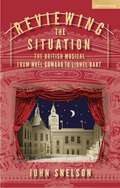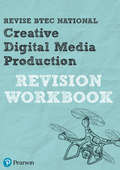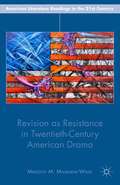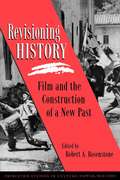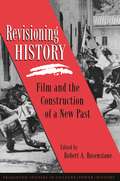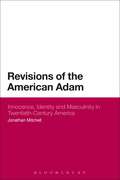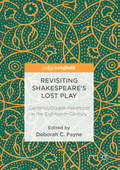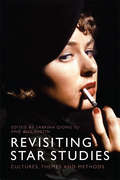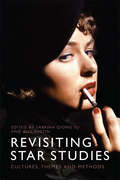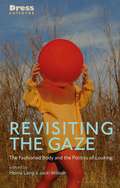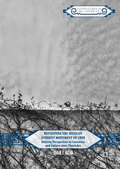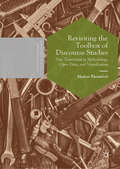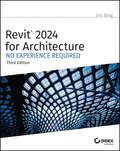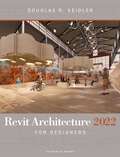- Table View
- List View
Reviewing Culture Online: Post-Institutional Cultural Critique across Platforms
by Maarit JaakkolaThis book examines how ordinary users review cultural products online, ranging from books to films and other art objects to consumer products. The book maps different communities—in institutional and non-institutional settings—which intersect with the genre of review, especially in the social web where reviewing is conducted on platforms such as Instagram, YouTube and Vimeo. The book, drawing on the key concepts of cultural intermediation, platformized cultural production and post-professionalism, looks at user-generated content in lifestyle communities beyond the binary of professional and amateur production.
Reviewing the Situation: The British Musical from Noël Coward to Lionel Bart
by John SnelsonThe British musical in its formative years has appeared in strikingly different guises: from the lasting hits of Oliver!, and Me and My Girl, to the successes of The Dancing Years, Bless the Bride and Expresso Bongo. This authoritative study traces what made these shows successes in the West End and how their qualities define a uniquely British interpretation of the genre. Cultural, sociological and political influences entwine with close reading of the dramatic and musical elements of this repertory to reveal a fascinating web of connections and contrasts between the times, the shows and the people who made them. Through detailed case studies, such as of The Boy Friend and Bitter Sweet, the rich individuality of each West End work is spotlighted, posing vital questions and intriguing answers as to what a British musical can be. Interdisciplinary in nature, this study brings together all the core materials to discover this period in the story of the British musical. Reviewing the Situation is insightful and lively, an invaluable resource for students and scholars of musical theatre and all those theatregoers drawn to the power of these classic British shows.
Reviewing the Situation: The British Musical from Noël Coward to Lionel Bart
by John SnelsonThe British musical in its formative years has appeared in strikingly different guises: from the lasting hits of Oliver!, and Me and My Girl, to the successes of The Dancing Years, Bless the Bride and Expresso Bongo. This authoritative study traces what made these shows successes in the West End and how their qualities define a uniquely British interpretation of the genre. Cultural, sociological and political influences entwine with close reading of the dramatic and musical elements of this repertory to reveal a fascinating web of connections and contrasts between the times, the shows and the people who made them. Through detailed case studies, such as of The Boy Friend and Bitter Sweet, the rich individuality of each West End work is spotlighted, posing vital questions and intriguing answers as to what a British musical can be. Interdisciplinary in nature, this study brings together all the core materials to discover this period in the story of the British musical. Reviewing the Situation is insightful and lively, an invaluable resource for students and scholars of musical theatre and all those theatregoers drawn to the power of these classic British shows.
Revise BTEC National Creative Digital Media Production Revision Workbook
by Julia Sandford-Cooke Lesley Davis Mr Philip Holmes Ms Sarah Holmes Daniel FreakerExam Board: Pearson EdexcelAcademic Level: BTEC NationalSubject: Creative Digital Media ProductionFirst teaching: September 2016First Exams: Summer 2017 For all four of the externally assessed units 1, 3, 5 and 8. Builds confidence with scaffolded practice questions. Unguided questions that allow students to test their own knowledge and skills in advance of assessment. Clear unit-by-unit correspondence between this Workbook and the Revision Guide and ActiveBook.
Revision as Resistance in Twentieth-Century American Drama (American Literature Readings in the 21st Century)
by M. Malburne-WadeAmerican dramas consciously rewrite the past as a means of determined criticism and intentional resistance. While modern criticism often sees the act of revision as derivative, Malburne-Wade uses Victor Turner's concept of the social drama and the concept of the liminal to argue for a more complicated view of revision.
Revisioning History: Film and the Construction of a New Past
by Robert A. RosenstoneIn Revisioning History thirteen historians from around the world look at the historical film on its own terms, not as it compares to written history but as a unique way of recounting the past. How does film construct a historical world? What are the rules, codes, and strategies by which it brings the past to life? What does that historical construction mean to us? In grappling with these questions, each contributor looks at an example of New History cinema. Different from Hollywood costume dramas or documentary films, these films are serious efforts to come to grips with the past; they have often grown out of nations engaged in an intense quest for historical connections, such as India, Cuba, Japan, and Germany. The volume begins with an introduction by Robert Rosenstone. Part I, "Contesting History," comprises essays by Geoff Eley (on the film Distant Voices, Still Lives), Nicholas B. Dirks (The Home and the World), Thomas Kierstead and Deidre Lynch (Eijanaika), and Pierre Sorlin (Night of the Shooting Stars). Contributing to Part II, "Visioning History," are Michael S. Roth (Hiroshima Mon Amour), John Mraz (Memories of Underdevelopment), Min Soo Kang (The Moderns) and Clayton R. Koppes (Radio Bikini). Part III, "Revisioning History" contains essays by Denise J. Youngblood (Repentance), Rudy Koshar (Hitler: A Film from Germany), Rosenstone (Walker), Sumiko Higashi (Walker and Mississippi Burning), and Daniel Sipe (From the Pole to the Equator).
Revisioning History: Film and the Construction of a New Past (Princeton Studies in Culture/Power/History #5)
by Robert A. RosenstoneIn Revisioning History thirteen historians from around the world look at the historical film on its own terms, not as it compares to written history but as a unique way of recounting the past. How does film construct a historical world? What are the rules, codes, and strategies by which it brings the past to life? What does that historical construction mean to us? In grappling with these questions, each contributor looks at an example of New History cinema. Different from Hollywood costume dramas or documentary films, these films are serious efforts to come to grips with the past; they have often grown out of nations engaged in an intense quest for historical connections, such as India, Cuba, Japan, and Germany. The volume begins with an introduction by Robert Rosenstone. Part I, "Contesting History," comprises essays by Geoff Eley (on the film Distant Voices, Still Lives), Nicholas B. Dirks (The Home and the World), Thomas Kierstead and Deidre Lynch (Eijanaika), and Pierre Sorlin (Night of the Shooting Stars). Contributing to Part II, "Visioning History," are Michael S. Roth (Hiroshima Mon Amour), John Mraz (Memories of Underdevelopment), Min Soo Kang (The Moderns) and Clayton R. Koppes (Radio Bikini). Part III, "Revisioning History" contains essays by Denise J. Youngblood (Repentance), Rudy Koshar (Hitler: A Film from Germany), Rosenstone (Walker), Sumiko Higashi (Walker and Mississippi Burning), and Daniel Sipe (From the Pole to the Equator).
Revisionist Rape-Revenge: Redefining a Film Genre
by Claire HenryConsidered a notorious subset of horror in the 1970s and 1980s, there has been a massive revitalization and diversification of rape-revenge in recent years. This book analyzes the politics, ethics, and affects at play in the filmic construction of rape and its responses.
Revisions of the American Adam: Innocence, Identity and Masculinity in Twentieth Century America (Continuum Literary Studies)
by Jonathan MitchellThe figure of the American Adam is a prevalent mythin US cultural history. Defined by R.W.B. Lewis in 1955 as "the hero of newadventure . . .an individual standing alone, self-reliant and self-propelling,ready to confront whatever awaited him with the aid of his own unique andinherent resources", the figure is discernable in the American renaissancewriters and in the imagery of the frontiersman, cowboy, gangster as well as inthe heroes of US action movies. Â Focusing on the American Adam as a paradigm of masculine identity formation,this monograph examines how this fantasy of an imaginary ideal identity has held an ideological sway over US identityin the main. Taking in a range of cultural texts, Jonathan Mitchell's study exploresthe complexities and contradictions of Adam's 'real' condition of existence to showhow the paradigm influences both masculinity and subsequently hegemonic USidentity as represented throughout twentieth-century US culture.
Revisions of the American Adam: Innocence, Identity and Masculinity in Twentieth Century America (Continuum Literary Studies)
by Jonathan MitchellThe figure of the American Adam is a prevalent mythin US cultural history. Defined by R.W.B. Lewis in 1955 as "the hero of newadventure . . .an individual standing alone, self-reliant and self-propelling,ready to confront whatever awaited him with the aid of his own unique andinherent resources", the figure is discernable in the American renaissancewriters and in the imagery of the frontiersman, cowboy, gangster as well as inthe heroes of US action movies. Focusing on the American Adam as a paradigm of masculine identity formation,this monograph examines how this fantasy of an imaginary ideal identity has held an ideological sway over US identityin the main. Taking in a range of cultural texts, Jonathan Mitchell's study exploresthe complexities and contradictions of Adam's 'real' condition of existence to showhow the paradigm influences both masculinity and subsequently hegemonic USidentity as represented throughout twentieth-century US culture.
Revisiting Postmodernism
by Terry Farrell Adam Nathaniel FurmanRevisiting Postmodernism offers an engaging, wide-ranging and highly illustrated account of postmodernism in architecture from its roots in the 1940s to its ongoing relevance today. This book invites readers to see Postmodernism in a new light: not just a style but a cultural phenomenon that embraces all areas of life and thrives on complexity and pluralism, in contrast to the strait-laced, single-style, top-down inclination of its predecessor, Modernism. While focusing on architecture, this book also explores aspects such as urban masterplanning, furniture design, art and literature. Looking at Postmodernism through the lens of examples from around the world, each chapter explores the movement in the UK on the one hand, and its international counterparts on the other, reflecting on the historical movement but also how postmodernism influences practices today. This book offers the insider’s view on postmodernism by the author, a recognised pioneer in the field of postmodern architecture and a prestigious and authoritative participant in the postmodern movement.
Revisiting Postmodernism
by Terry Farrell Adam Nathaniel FurmanRevisiting Postmodernism offers an engaging, wide-ranging and highly illustrated account of postmodernism in architecture from its roots in the 1940s to its ongoing relevance today. This book invites readers to see Postmodernism in a new light: not just a style but a cultural phenomenon that embraces all areas of life and thrives on complexity and pluralism, in contrast to the strait-laced, single-style, top-down inclination of its predecessor, Modernism. While focusing on architecture, this book also explores aspects such as urban masterplanning, furniture design, art and literature. Looking at Postmodernism through the lens of examples from around the world, each chapter explores the movement in the UK on the one hand, and its international counterparts on the other, reflecting on the historical movement but also how postmodernism influences practices today. This book offers the insider’s view on postmodernism by the author, a recognised pioneer in the field of postmodern architecture and a prestigious and authoritative participant in the postmodern movement.
Revisiting Shakespeare’s Lost Play: Cardenio/Double Falsehood in the Eighteenth Century
by Deborah C. PayneThis collection of essays centres on Double Falsehood, Lewis Theobald’s 1727 adaptation of the “lost” play of Cardenio, possibly co-authored by John Fletcher and William Shakespeare. In a departure from most scholarship to date, the contributors fold Double Falsehood back into the milieu for which it was created rather than searching for traces of Shakespeare in the text. Robert D. Hume’s knowledge of theatre history permits a fresh take on the forgery question as well as the Shakespeare authorship controversy. Diana Solomon’s understanding of eighteenth-century rape culture and Jean I. Marsden’s command of contemporary adaptation practices both emphasise the play’s immediate social and theatrical contexts. And, finally, Deborah C. Payne’s familiarity with the eighteenth-century stage allows for a reconsideration of Double Falsehood as integral to a debate between Theobald, Alexander Pope, and John Gay over the future of the English drama.
Revisiting Star Studies: Cultures, Themes and Methods
by Sabrina Qiong Yu Guy AustinChallenges traditional Hollywood-derived models of star studiesIs classical Hollywood stardom the last word on film stars? How do film stars function in non-Hollywood contexts, such as Bollywood, East Asia and Latin America, and what new developments has screen stardom undergone in recent years, both in Hollywood and elsewhere? Gathering together the most important new research on star studies, with case studies of stars from many different cultures, this diverse and dynamic collection looks at film stardom from new angles, challenging the received wisdom on the subject and raising important questions about image, performance, bodies, voices and fans in cultures across the globe. From Hollywood to Bollywood, from China to Italy, and from Poland to Mexico, this collection revisits the definitions and origins of star studies, and points the way forward to new ways of approaching the field.Key featuresFeatures cutting-edge research on stardom and fandom from a range of different cultures, contributed by a diverse and international range of scholarsGenerates new critical models that address non-Hollywood forms of stardom, as well as under-researched areas of stardom in Hollywood itselfRevisits the definitions of stars and star studies that are previously defined by the study of Hollywood stardom, then points the way forward to new ways of approaching the fieldLooks at stars/stardom within a new local/translocal model, to overcome the Hollywood-centrism inherent to the existing national/transnational modelBrings into light various types of previously unacknowledged star textsEmploys a dynamic inter-disciplinary approachContributorsGuy Austin, Newcastle UniversityLinda Berkvens, University of Sussex Pam Cook, University of Southampton Elisabetta Girelli, University of St Andrews Sarah Harman, Brunel UniversityStella Hockenhull, University of WolverhamptonLeon Hunt, Brunel University Kiranmayi Indraganti, Srishti Institute of Art, Design and TechnologyJaap Kooijman, University of AmsterdamMichael Lawrence, University of SussexAnna Malinowska, University of SilesiaLisa Purse, University of ReadingClarissa Smith, University of SunderlandNiamh Thornton, University of Liverpool Yiman Wang, University of California-Santa CruzSabrina Qiong Yu, Newcastle UniversityYingjin Zhang, University of California-San Diego
Revisiting Star Studies: Cultures, Themes and Methods
by Sabrina Qiong Yu Guy AustinChallenges traditional Hollywood-derived models of star studiesIs classical Hollywood stardom the last word on film stars? How do film stars function in non-Hollywood contexts, such as Bollywood, East Asia and Latin America, and what new developments has screen stardom undergone in recent years, both in Hollywood and elsewhere? Gathering together the most important new research on star studies, with case studies of stars from many different cultures, this diverse and dynamic collection looks at film stardom from new angles, challenging the received wisdom on the subject and raising important questions about image, performance, bodies, voices and fans in cultures across the globe. From Hollywood to Bollywood, from China to Italy, and from Poland to Mexico, this collection revisits the definitions and origins of star studies, and points the way forward to new ways of approaching the field.Key featuresFeatures cutting-edge research on stardom and fandom from a range of different cultures, contributed by a diverse and international range of scholarsGenerates new critical models that address non-Hollywood forms of stardom, as well as under-researched areas of stardom in Hollywood itselfRevisits the definitions of stars and star studies that are previously defined by the study of Hollywood stardom, then points the way forward to new ways of approaching the fieldLooks at stars/stardom within a new local/translocal model, to overcome the Hollywood-centrism inherent to the existing national/transnational modelBrings into light various types of previously unacknowledged star textsEmploys a dynamic inter-disciplinary approachContributorsGuy Austin, Newcastle UniversityLinda Berkvens, University of Sussex Pam Cook, University of Southampton Elisabetta Girelli, University of St Andrews Sarah Harman, Brunel UniversityStella Hockenhull, University of WolverhamptonLeon Hunt, Brunel University Kiranmayi Indraganti, Srishti Institute of Art, Design and TechnologyJaap Kooijman, University of AmsterdamMichael Lawrence, University of SussexAnna Malinowska, University of SilesiaLisa Purse, University of ReadingClarissa Smith, University of SunderlandNiamh Thornton, University of Liverpool Yiman Wang, University of California-Santa CruzSabrina Qiong Yu, Newcastle UniversityYingjin Zhang, University of California-San Diego
Revisiting the Gaze: The Fashioned Body and the Politics of Looking (Dress Cultures)
by Morna Laing Jacki WillsonIn 1975 Laura Mulvey published her seminal essay on the male gaze, ushering in a new era in understanding the politics and theory of looking at the female body. Since then, feminist thinking has expanded upon and revised Mulvey's theory and much of the Western world has seen a resurgence in feminist activism as well as the rise of neoliberalism and shifts in digital culture and (self-)representation. For the first time, this book addresses what it means to look at the fashioned female body in this radical new landscape. In chapters exploring the fashioned body within contexts such as queerness, veiling, blackness, pregnancy, fatness, and criminality, Revisiting the Gaze addresses intersectional debates in feminism and re-evaluates the concept of the gaze in light of recent social and political changes. With an interdisciplinary approach, bridging fashion and fine art, this book opens the door to discussions about the male gaze and the fashioned body.
Revisiting the Gaze: The Fashioned Body and the Politics of Looking (Dress Cultures)
In 1975 Laura Mulvey published her seminal essay on the male gaze, ushering in a new era in understanding the politics and theory of looking at the female body. Since then, feminist thinking has expanded upon and revised Mulvey's theory and much of the Western world has seen a resurgence in feminist activism as well as the rise of neoliberalism and shifts in digital culture and (self-)representation. For the first time, this book addresses what it means to look at the fashioned female body in this radical new landscape. In chapters exploring the fashioned body within contexts such as queerness, veiling, blackness, pregnancy, fatness, and criminality, Revisiting the Gaze addresses intersectional debates in feminism and re-evaluates the concept of the gaze in light of recent social and political changes. With an interdisciplinary approach, bridging fashion and fine art, this book opens the door to discussions about the male gaze and the fashioned body.
Revisiting the Mexican Student Movement of 1968: Shifting Perspectives in Literature and Culture since Tlatelolco (Literatures of the Americas)
by Juan J. RojoTracing the evolution of Mexican literary and cultural production following the Tlatelolco massacre, this book shows its progression from a homogeneous construct set on establishing the “true” history of Tlatelolco against the version of the State, to a more nuanced and complex series of historical narratives. The initial representations of the events of 1968 were essentially limited to that of the State and that of the Consejo Nacional de Huelga (National Strike Council) and only later incorporated novels and films. Juan J. Rojo examines the manner in which films, posters, testimonios, and the Memorial del 68 expanded the boundaries of those initial articulations to a more democratic representation of key participants in the student movement of 1968.
Revisiting the Past in Museums and at Historic Sites (Routledge Research in Museum Studies)
by Anca I. Lasc Andrew McClellan Änne SöllRevisiting the Past in Museums and at Historic Sites demonstrates that museums and historic spaces are increasingly becoming "backdrops" for all sorts of appropriations and interventions that throw new light upon the objects they comprise and the pasts they reference. Rooted in new scholarship that expands established notions of art installations, museums, period rooms, and historic sites, the book brings together contributions from scholars from intersecting disciplines. Arguing that we are witnessing a paradigm shift concerning the place of historic spaces and museums in the contemporary imaginary, the volume shows that such institutions are merging traditional scholarly activities tied to historical representation and inquiry with novel modes of display and interpretation, drawing them closer to the world of entertainment and interactive consumption. Case studies analyze how a range of interventions impact historic spaces and conceptions of the past they generate. The book concludes that museums and historic sites are reinventing themselves in order to remain meaningful and to play a role in societies aspiring to be more inclusive and open to historical and cultural debate. Revisiting the Past in Museums and at Historic Sites will be of interest to students and faculty who are engaged in the study of museums, art history, architectural and design history, social and cultural history, interior design, visual culture, and material culture.
Revisiting the Past in Museums and at Historic Sites (Routledge Research in Museum Studies)
by Anca I. Lasc Andrew McClellan Änne SöllRevisiting the Past in Museums and at Historic Sites demonstrates that museums and historic spaces are increasingly becoming "backdrops" for all sorts of appropriations and interventions that throw new light upon the objects they comprise and the pasts they reference. Rooted in new scholarship that expands established notions of art installations, museums, period rooms, and historic sites, the book brings together contributions from scholars from intersecting disciplines. Arguing that we are witnessing a paradigm shift concerning the place of historic spaces and museums in the contemporary imaginary, the volume shows that such institutions are merging traditional scholarly activities tied to historical representation and inquiry with novel modes of display and interpretation, drawing them closer to the world of entertainment and interactive consumption. Case studies analyze how a range of interventions impact historic spaces and conceptions of the past they generate. The book concludes that museums and historic sites are reinventing themselves in order to remain meaningful and to play a role in societies aspiring to be more inclusive and open to historical and cultural debate. Revisiting the Past in Museums and at Historic Sites will be of interest to students and faculty who are engaged in the study of museums, art history, architectural and design history, social and cultural history, interior design, visual culture, and material culture.
Revisiting the Toolbox of Discourse Studies: New Trajectories in Methodology, Open Data, and Visualization (Postdisciplinary Studies in Discourse)
by Markus RheindorfThis book revisits discourse analytic practice, analyzing the idea that the field has access to, provides, or even constitutes a ‘toolbox’ of methods. The precise characteristics of this toolbox have remained largely un-theorized, and the author discusses the different sets of tools and their combinations, particularly those that cut across traditional divides, such as those between disciplines or between quantitative and qualitative methods. The author emphasizes the potential value of integrating methods in terms of triangulation and its specific benefits, arguing that current trends in Open Science require Discourse Studies to re-examine its methodological scope and choices, and move beyond token acknowledgements of ‘eclecticism’. In-depth case studies supplement the methodological discussion and demonstrate the challenges and benefits of triangulation. This book will be a valuable resource for students and scholars in Discourse Studies, particularly those with an interest in combining methods and working across disciplines.
Revisualising Intersectionality
by Elahe Haschemi Yekani Magdalena Nowicka Tiara RoxanneRevisualising Intersectionality offers transdisciplinary interrogations of the supposed visual evidentiality of categories of human similarity and difference. This open-access book incorporates insights from social and cognitive science as well as psychology and philosophy to explain how we visually perceive physical differences and how cognition is fallible, processual, and dependent on who is looking in a specific context. Revisualising Intersectionality also puts into conversation visual culture studies and artistic research with approaches such as gender, queer, and trans studies as well as postcolonial and decolonial theory to complicate simplified notions of identity politics and cultural representation. The book proposes a revision of intersectionality research to challenge the predominance of categories of visible difference such as race and gender as analytical lenses.
Revit 2024 for Architecture: No Experience Required
by Eric WingThe latest and most authoritative version of the popular step-by-step tutorial for Revit Architecture The newly revised third edition of Revit 2024 for Architecture: No Experience Required is the latest update to the market-leading, real-world guide for learning and building with Revit—the powerful and sophisticated Building Information Modeling (BIM) software used by professionals around the world. This popular, user-friendly book teaches you the Revit interface and helps you understand the foundational concepts and features of the software. You’ll learn to design, document, and present a 3D BIM project with a continuous, step-by-step tutorial that guides you through every phase of the project: from placing walls, doors, windows, structural elements, dimensions, and text, to generating documentation, advanced detailing, site grading, construction scheduling, material takeoffs, and more. In addition, this book helps you prepare for the Autodesk Revit Architecture Certification Exam. Throughout the book, you will find helpful insights directly related to the exam. The last two chapters are dedicated entirely to the exam with a practice test at the end of the book. You’ll also: Learn each phase of designing, documenting, and presenting a four-story office building using a simple yet engaging continuous tutorial Follow the tutorial sequentially or jump to any chapter by downloading the project files from the Sybex website Use the start-to-finish tutorial project as a reference for your own real-world projects and to develop a powerful Revit skillset Gain thorough knowledge of Revit’s essential concepts and features to make the move from 2D drafting to 3D building information modeling Get up to speed with advanced features, including new coverage of advanced walls, families, sites, topography, and moreThe Autodesk Revit 2024 for Architecture: No Experience Required, 3rd Edition, is the go-to guide for professionals and students seeking to learn Revit’s essential functions quickly and effectively.
Revit 2024 for Architecture: No Experience Required
by Eric WingThe latest and most authoritative version of the popular step-by-step tutorial for Revit Architecture The newly revised third edition of Revit 2024 for Architecture: No Experience Required is the latest update to the market-leading, real-world guide for learning and building with Revit—the powerful and sophisticated Building Information Modeling (BIM) software used by professionals around the world. This popular, user-friendly book teaches you the Revit interface and helps you understand the foundational concepts and features of the software. You’ll learn to design, document, and present a 3D BIM project with a continuous, step-by-step tutorial that guides you through every phase of the project: from placing walls, doors, windows, structural elements, dimensions, and text, to generating documentation, advanced detailing, site grading, construction scheduling, material takeoffs, and more. In addition, this book helps you prepare for the Autodesk Revit Architecture Certification Exam. Throughout the book, you will find helpful insights directly related to the exam. The last two chapters are dedicated entirely to the exam with a practice test at the end of the book. You’ll also: Learn each phase of designing, documenting, and presenting a four-story office building using a simple yet engaging continuous tutorial Follow the tutorial sequentially or jump to any chapter by downloading the project files from the Sybex website Use the start-to-finish tutorial project as a reference for your own real-world projects and to develop a powerful Revit skillset Gain thorough knowledge of Revit’s essential concepts and features to make the move from 2D drafting to 3D building information modeling Get up to speed with advanced features, including new coverage of advanced walls, families, sites, topography, and moreThe Autodesk Revit 2024 for Architecture: No Experience Required, 3rd Edition, is the go-to guide for professionals and students seeking to learn Revit’s essential functions quickly and effectively.
Revit Architecture 2022 for Designers
by Douglas R. SeidlerRevit® is rapidly replacing AutoCAD as the digital drawing tool of choice for architects and interior designers. This book aims to help design students master Revit® as a tool in the design studio and in practice.Revit® Architecture 2022 for Designers provides both a thorough primer for new learners and expanded conceptual discussion for design professionals. The progressive introduction of concepts (chapters build on previous chapters), digital exercises, and professional examples make this book easy to follow for learners new to Revit®. Packed with visual examples, it is written specifically for architecture and interior design students. NEW TO THIS EDITION· Instruction graphics updated for Revit® Architecture 2022 features and user interface· New instruction for drawing with metric units· New instruction on importing PDFs (Chapter 2), Photorealistic Rendering (Chapter 7), and Advanced Modeling (Chapter 10)
